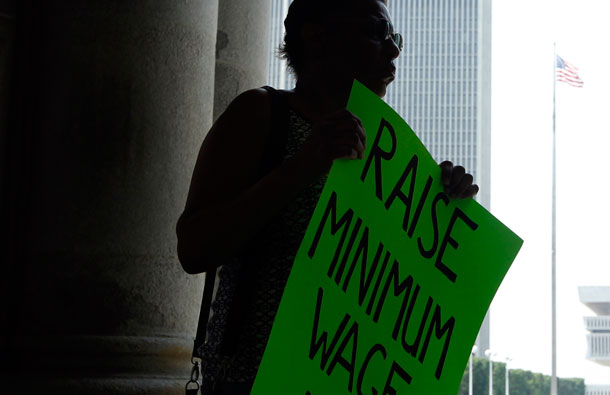
Women Are the Biggest Losers from Failure to Raise Minimum Wage
Earning the Federal Minimum Wage Keeps Women, Especially Those of Color, Poor
Boosting the minimum wage will be a particular boon to women and people of color, who make up a disproportionate share of minimum wage earners, argue David Madland and Nick Bunker.
Media Contact
Government Affairs

(AP/Mike Groll)
See also: The Facts on Raising the Minimum Wage When Unemployment Is High by T. William Lester, David Madland, and Nick Bunker
The current federal minimum wage of $7.25 per hour is far too low. A full-time worker earning the minimum wage makes just $15,080 per year, below the poverty line for a family of three. From 1968 to 2010, incomes for the top 1 percent of earners increased by 110 percent, but the inflation-adjusted value of the minimum wage has fallen by 31 percent. If the federal minimum wage had kept pace with the rising cost of living over the past 40 years, it would be $10.52 per hour today.
Women are disproportionately harmed by a low minimum wage because women—and especially women of color—are much more likely hold low-wage jobs than men. The typical woman earns 77 cents for every dollar the typical man does, and the fact that women are more likely to be minimum-wage earners than men contributes to that disparity. This gap is especially distressing now that two-thirds of mothers are either the breadwinners or co-breadwinners for their families.
In 2011 more than 62 percent of minimum-wage workers were women compared to just 38 percent of male minimum-wage workers. Slightly more than 2.5 million women earn the minimum wage or less, while approximately 1.5 million men do. This imbalance is even more drastic once you consider that women were just 46.9 percent of all employed workers in 2011.
Female workers earning the minimum wage are also disproportionately workers of color. African American women were 15.8 percent of female workers making the minimum wage in 2011 compared to 12.3 percent of all employed workers. Similarly, Hispanic women were 16.5 percent of female minimum wage earners but were only 12.5 percent of employed workers.
Women also disproportionately earn the subminimum wage for tipped workers such as waitresses and bartenders: Sixty-six percent of workers earning the federal tipped minimum wage of $2.13 were women in 2010, according to analysis by Restaurant Opportunities Centers United. Moreover, the federal tipped minimum wage hasn’t been increased since 1991.
Finally, women earning the minimum wage are also overwhelmingly adults—not teenagers. More than 76 percent of women earning the minimum wage are 20 years old or older. In fact, 40 percent of female minimum-wage earners are over the age of 30.
In short, the minimum wage is not just a worker policy—it is also a woman’s policy.

Who would be affected by a minimum wage hike?
A hike in the minimum wage wouldn’t only affect those who earn the minimum wage. Certainly, those who earn between the current minimum wage and the new minimum wage would be directly affected and see their wages increase. But workers earning near the new minimum wage would also see an indirect increase due to what economists call a “spillover effect.”
The following chart describes the workers who would have been affected by increasing the minimum wage to $9.80 an hour, as proposed by Sen. Tom Harkin (D-IA) in his Rebuild America Act. More than 55 percent of workers affected by the minimum wage hike would be women. About 57 percent of those directly affected and 51.3 percent of those indirectly affected by the increase would be women. Similarly, women of color would be especially affected by the increase: Sixteen percent of affected female workers would be African American, while 19.3 percent would be Hispanic. The vast majority of women who would be affected by an increase in the minimum wage are also adults. More than 88 percent of female workers who would see a wage increase are older than 20. Nearly 55 percent of affected female workers would be older than 30, and 39 percent would be above the age of 40.

Raising the minimum wage would give a needed boost to the incomes of low-wage women. This one move alone certainly wouldn’t solve all of the inequities women face in the labor market, but it would be a step in the right direction.
The hard work done by employees in low-wage jobs should be rewarded adequately. Improving pay for these workers—both the women and men—is vital for rebuilding the middle class and creating an economy that works for all of us.
David Madland is Director of the American Worker Project at the Center for American Progress Action Fund. Nick Bunker is a Research Assistant with the project.
See also:
- The Facts on Raising the Minimum Wage When Unemployment Is High by T. William Lester, David Madland, and Nick Bunker
The positions of American Progress, and our policy experts, are independent, and the findings and conclusions presented are those of American Progress alone. A full list of supporters is available here. American Progress would like to acknowledge the many generous supporters who make our work possible.
Authors

Nick Bunker
Research Associate


